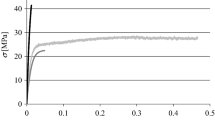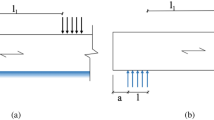Abstract
The strength prediction of adhesively bonded timber joints is difficult due to the anisotropic and brittle nature of the adherends, the complex stress distribution as well as the uncertainties regarding the associated material resistance. This paper describes a probabilistic method for the strength prediction of balanced double lap timber joints. The method considers the statistical variation and the size effect in the strength of timber using a Weibull statistical function. The design method presents an explanation for the increased resistance of local zones subjected to high stress peaks as it takes into account not only the magnitude of the stress distributions, but also the volume over which they act. The predicted joint strengths are slightly underestimated compared with the experimental results due to inaccurate upper tail modelling of the material strength by the Weibull statistical distribution. The probabilistic method provides reasonable results for brittle joint failure and has immediate application in the design of adhesively bonded timber joints.





Similar content being viewed by others
References
Adams RD, Pepiatt NA (1974) Stress analysis of adhesive bonded lab joints. J Strain Anal 9:185–196
Barrett JD, Foschi RO, Fox SP (1975) Perpendicular-to-grain strength of Douglas-fir. Can J Civil Eng 2:50–57
Bažant ZP (1999) Size effect on structural strength: a review. Arch Appl Mech 69(9–10):703–725
Bohannan B (1966) Effect of size on bending strength of wood members. Research paper FPL 56, Forest Products Laboratory, Madison
Clarke JL (1996) Structural design of polymer composites - eurocomp design code and handbook. London: E & FN Spon, London
Clouston P, Lam F, Barrett JD (1998) Incorporating size effects in the Tsai-Wu strength theory for Douglas-fir laminated veneer. Wood Sci Technol 32(3):215–226
Colling F (1986) Einfluss des Volumens und der Spannungsverteilung auf die Festigkeit eines Rechteckträgers (in German). Holz Roh- Werkst 44(4):121–125
Crocombe AD, Richardson G (1995) A Unified approach for predicting the strength of cracked and non-cracked adhesive joints. J Adhesion 49:211–244
Da Silva LFM, Das Neves PJC, Adams RD, Wang A, Spelt JK (2009) Analytical models of adhesively bonded joints–Part II: comparative study. Int J Adhesion Adhesives 29(3):331–341
Eberhardsteiner J (2002) Mechanisches Verhalten von Fichtenholz - Experimentelle Bestimmung der biaxialen Festigkeitseigenschaften. (in German). Springer, Vienna, Austria
Foschi RO, Barrett JD (1976) Longitudinal shear strength of Douglas-Fir. Can J Civil Eng 3(2):198–208
Grosse M, Rautenstrauch K (2004) Numerical modelling of timber and fasteners used in timber-concrete-composite constructions. In: Proceedings of the CIB-W18. Edinburgh, Scotland, 37-7-16
Hemmer K (1984) Versagensarten des Holzes der Weisstanne unter mehrachsiger Beanspruchung. (in German). Dissertation, Universität Karlsruhe, Germany
Kasal B, Leichti RJ (2005) State of the art in multiaxial phenomenological failure criteria for wood members. Prog Struct Eng Mater 7(1):3–13
Norris CB (1962) Strength of orthotropic materials subjected to combined stresses. Report No.1816, Forest Products Laboratory, Madison
Smith I, Landis E, Gong M (2003) Fracture and fatigue in wood. Wiley, Chichester
Spengler R (1986) Festigkeitsverhalten von Brettelementen aus Fichte unter zweiachsiger Beanspruchung. (in German). Report 68098450340, Technical University Munich, Germany
Tannert T, Vallée T, Hehl S (2011) Experimental and numerical investigations on adhesively bonded timber joints. doi:10.1007/s00226-011-0423-1
Vallée T, Correia JR, Keller T (2006) Probabilistic strength prediction for double lap joints composed of pultruded GFRP profiles–Part II: strength prediction. Compos Sci Technol 66(13):1915–1930
Vallée T, Keller T, Fourestey G, Fournier B, Correia JR (2009) Adhesively bonded joints composed of pultruded adherends: considerations at the upper tail of the material strength statistical distribution. Probabilistic Eng Mech 24(3):358–366
Weibull W (1939) A statistical theory of strength of materials. Proceedings of the Royal Swedish Institute, Research No.151, Stockholm, Sweden
Xavier JC, Garrido NM, Oliveira M, Morais JL, Camanho PP, Pierron F (2004) A comparison between the Iosipescu and off-axis shear test methods for the characterization of Pinus Pinaster Ait. Composites Part A Appl Sci Manuf 35(7–8):827–840
Author information
Authors and Affiliations
Corresponding author
Rights and permissions
About this article
Cite this article
Tannert, T., Vallée, T. & Hehl, S. Probabilistic strength prediction of adhesively bonded timber joints. Wood Sci Technol 46, 503–513 (2012). https://doi.org/10.1007/s00226-011-0424-0
Received:
Published:
Issue Date:
DOI: https://doi.org/10.1007/s00226-011-0424-0




